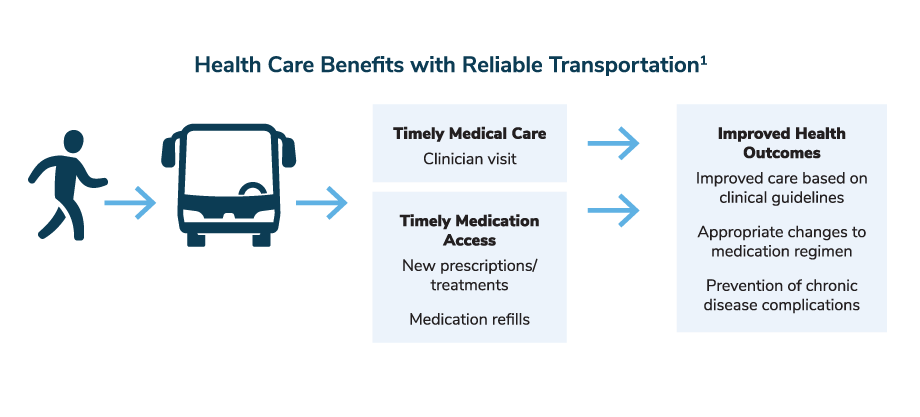Safe, affordable and reliable transportation is a cornerstone of ensuring the health and livelihoods of people around the world. Research shows that transportation barriers can serve as a roadblock to obtaining nutritious food, timely medical care and medications, ultimately leading to worse clinical outcomes.1 In 2017, 3.6 million people in the U.S. did not access medical care because they experienced transportation barriers.2 In some countries, poor road infrastructure, few cars and high transportation costs have delayed access to emergency care.3 The figure below shows how reliable transportation impacts health.

In addition to affecting employee health, research shows that safe and reliable transportation influences access to employment opportunities, as well as employee productivity and turnover. For example, one company noticed increased employee turnover during their second shift, which was attributed to employees’ lack of reliable transportation. This problem resulted in a decrease in company productivity and growth.4 On the other hand, studies show that reliable and safe transportation promotes and reinforces healthy behaviors while helping employees remain productive and engaged.2
Worldwide Problem
Like other social determinants, access to safe and reliable transportation is dependent on other social and economic factors, such as income and geography. For instance, low wage workers living in suburban areas of the U.S. have very limited access to buses, trains and other modes of public transportation needed in order to go to work, access healthy foods and meet their basic needs.5,6 However, in 2015, approximately 9% of American households still do not have access to a vehicle.7 That means almost 3 million families depended upon potentially unreliable modes of transportation to complete essential tasks.
In Latin America and the Caribbean, rapidly growing cities and increased poverty and inequality have prompted some people to live in informal housing or on the outskirts of bigger cities.8 These areas have little or no road infrastructure and are not serviced by formal transit systems, causing people to forgo trips or endure long and costly commutes just to get to work or perform everyday tasks.8
Long commute times also impact employee safety. In India, women working the night shift at call centers often fear for their safety when commuting home. Some companies offer “night drops,” where they provide employees transportation to their home, but the majority do not, leaving many women to make a choice between their safety and work.9 These factors only aggravate pre-existing social inequities.
Ideas for Action
Transportation is a conduit for each social determinant of health. Because transportation touches many aspects of a person’s life, its adequacy and reliability are essential.2 Employers have an opportunity to help in several ways, including by:
- Providing transportation vouchers for Uber, Lyft or other ride-sharing applications so employees can get to health care appointments.
- Encouraging local health plans to identify resources available to help employees who don’t have access to regular transportation to get to and from health care appointments.
- Being flexible with employees, especially those with long commutes to work, by offering flexible work hours. Revise attendance and tardiness policies to allow for some degree of flexibility and the ability to work remotely, when and where it is appropriate.
- Providing a pretax deduction for transportation to and from work or offering commuter benefits with an employer contribution in cities, where appropriate.
- Providing company-sponsored transportation to work for employees living in communities with unsafe or unreliable transportation.
More Topics
Articles & Guides-
IntroductionSocial Determinants: Acting to Achieve Well-being for All
-
Full GuideSocial Determinants: Full Guide
-
Part 1Social Determinants: Why Benefits and Well-being Leaders Should Address Social Determinants
-
Part 2Social Determinants: How Benefits and Well-being Leaders Can Get Started
-
Part 3Social Determinants: Income
-
Part 4Social Determinants: Access to Health Care Services
-
Part 5Social Determinants: Food Access and Insecurity
-
Part 6Social Determinants: Transportation
-
Part 7Social Determinants: Childcare
-
Part 8Social Determinants: Housing Instability
-
Part 9Social Determinants: Racism
This content is for members only. Already a member?
Login
![]()
